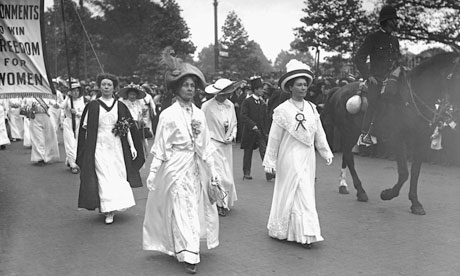The June Purvis article titled “ 'Deeds, Not Words': Daily
Life in the Women's Social and Political Union in Edwardian Britain” is
especially important to the study of the women’s movement in Europe because she
outlines the details of actions taken by WSPU members as well as other lesser
known women’s suffrage organizations. Purvis reveals that the point of
separation between the WSPU and these other organizations, as well as the
reason why the WSPU’s fame continues today, is their “unladylike tactics” (CP
229). This did not occur accidentally,
as Purvis explains in the article, Christabel Pankhurst and Annie Kenney made a
plan in October of 1905 to heckle male politicians in order to get arrested and
gain attention for their cause (CP 229). The media attention that the women
received that day was the beginning of the WSPU’s turn towards militancy.
During
its infancy, the WSPU seems to have been similar to other suffrage
organizations that are now rarely discussed. The Women’s Freedom League and the
National Union of Women’s Suffrage Societies are two of the groups which Purvis
calls ladylike and law-abiding. To be more distinct, she calls these women “suffragists,”
while the WSPU members are most commonly known as suffragettes, a thin but
important difference. An example of their ladylike tactics includes campaigning
at socialist and trade union meetings as well as creating posters and
participating in marches (CP 229).
Although their “unladylike tactics”
began in 1905 with minor offenses such as heckling politicians and spitting at
officers, the actions taken by the WSPU women in 1912 were definitively
militant in nature. June Purvis writes that the women burned golf courses and
empty buildings, they cut telephone wires, and there was mass property damage
at the hands of the WSPU including broken windows (CP 229). For being so
militant, these women actually tried their best to remain ladylike throughout
their protests. Purvis includes a quote from a suffragette in her article which
reveals that the WSPU was concerned with acting humane. The suffragette stated,
“Mrs. Pankhurst gave us strict orders about these fires: there was not a cat or
a canary to be killed; no life; we were only allowed to give our lives” (CP
229). Clearly, the actions of the WSPU were well planned out and their
intention was not to cause harm to anyone, but only to make people listen. The
smile on Annie Kenney’s face in the picture below shows that she intended on
being arrested so that her mission could get the publicity it deserved.



























